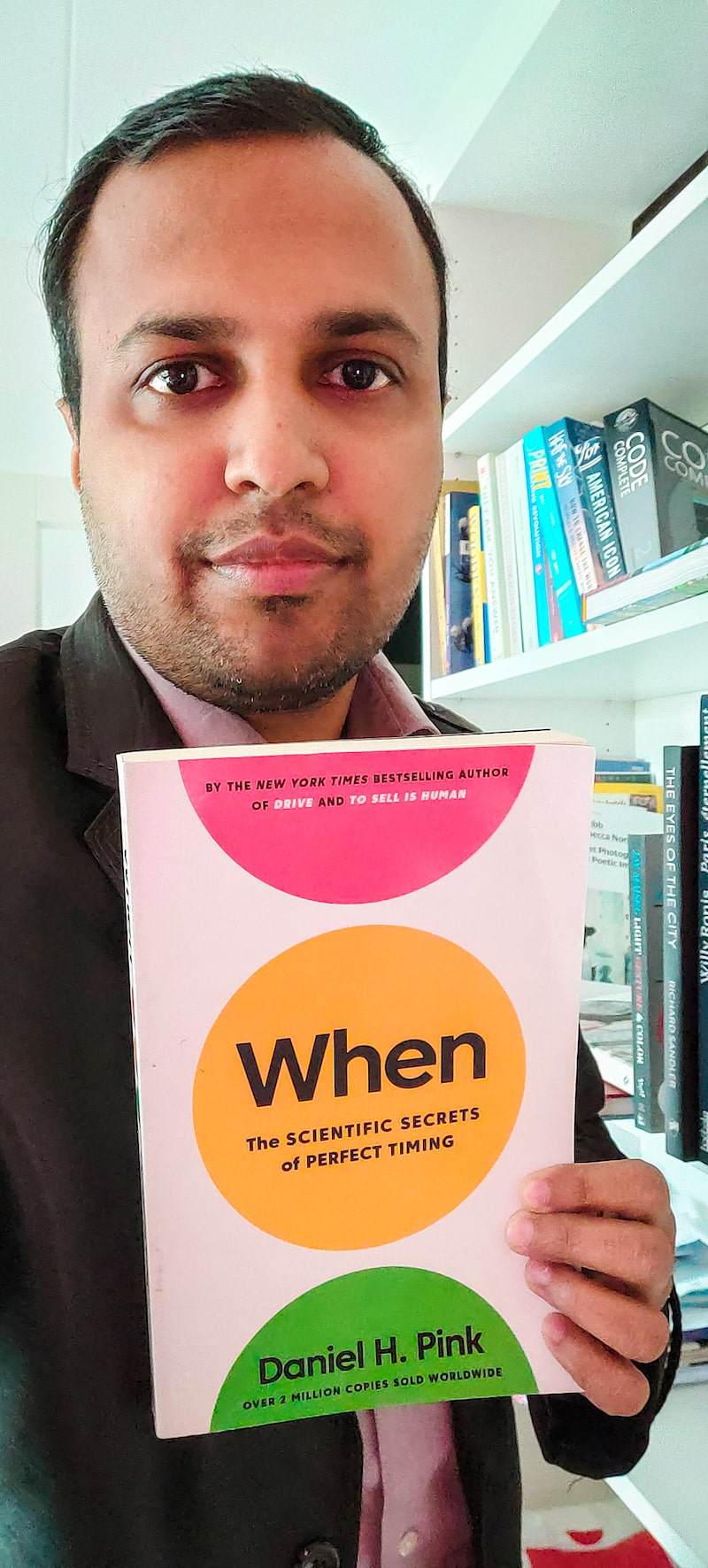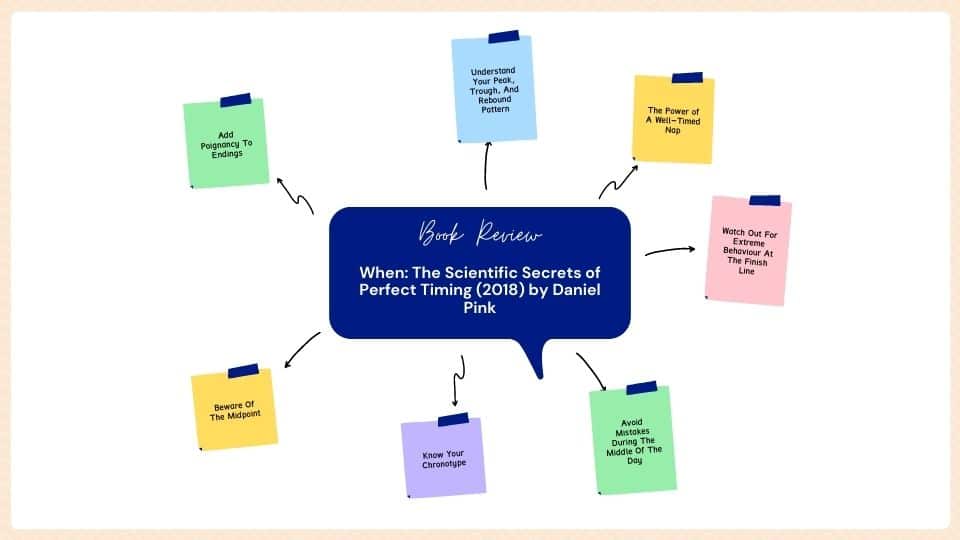We spend a good part of our life thinking about time. Right from when to wake up in the morning, to meeting work deadlines, to when is the right time to make a decision, we all know that timing plays a crucial role in our lives.
In the words of Miles Davies, ‘Time isn’t the main thing, It’s the only thing’. His words are applicable to each one of us. When: The Scientific Secrets of Perfect Timing (2018) by Daniel Pink discusses the strong connection we share with time, how habituated we are to our routines, and why we do what we do when we do it.
1. Understand The Peak, Trough, And Rebound Pattern
We go through our days in a consistent routine. We get up, complete our chores, have breakfast, read the newspaper, get dressed, head to work, have lunch, head back home, spend time with family at dinner and go to bed. However, underneath these daily routines, our moods also follow a general time pattern.

Researchers from Cornell University studied the mood trends of people on Twitter. They found a consistent pattern through the day where positive moods peak in the mornings, dip down in the afternoon and pick up again in the evenings. Apart from these studies, many behavioral scientists, using the Day Reconstruction Method (DRM) – a method of analyzing peoples’ day hour-by-hour, found that positivity levels follow the Peak, Trough, and Rebound pattern. Similarly, negativity levels peak in the afternoon and wane towards the evenings.
Daniel Pink shows in the book that the peak, trough, and rebound pattern has a significant effect on our mood. Our moods affect the quality of the work we do in the afternoon’s trough time. Therefore, the most important calls, meetings, and deals are advised to be scheduled in the daytime when our mood is at its peak.
2. Know Your Chronotype
Along with the pattern our emotional state follows, each one of us has an internal clock or chronotype. While a majority of the people follow the same consistent pattern of morning peak, afternoon trough, and evening rebound, there are two other chronotypes that differ from the general type – the night owls and larks who consist of 20-25 percent of the general population.
Night Owls
Night owls experience their peak around 9:00 PM and rebound in the morning. These are usually creative people and tend to be a little more neurotic, depressive, and impulsive than the general group. Night owls should use their night-time peak to handle analytical tasks and use their morning rebound for creative work.
Larks
Larks (like I am) on the other hand experience their peak, trough, and rebound a few hours earlier than everyone else. They are the ‘early to bed early to rise’ people and have stable, happy, and introverted personality types. For larks, the reverse works. They should assign analytical tasks for their early morning and creative work for evenings.
The author of the book gives various examples to show why it is important that we understand our chronotype to help schedule our day and maximize productivity.
3. Avoid Mistakes During The Middle Of The Day
Studies have shown that the elderly and small children tend to follow lark patterns, and we tend to change to the night owl pattern once we hit the teenage years. This is the reason why most teenagers suffer in analytical subjects such as math when schools start early in the morning.
Another observation in hospitals has shown that standards of hygiene and care drop towards the afternoons. Moreover, the staff is more prone to medical mistakes during the trough period.
Daniel Pink adds that these midday mistakes are avoidable by taking breaks. The University of Michigan Medical Centre has proven that taking ‘vigilance breaks’ shows improvements in the rate of medical errors. Similarly, the introduction of twenty-minute breaks before assessments in some Denmark schools has shown improvement in scores.
Schools, colleges, hospitals, and other work organizations should take cognizance of this fact and introduce regular breaks for better productivity, and to avoid midday errors.
4. The Power of A Well-Timed Nap
It is important to understand why breaks are beneficial. Research on the usage of Desktime, a desktop productivity software company, revealed that for every fifty-two minutes of work, a person needs seventeen minutes of break time for maximum productivity. Sadly, in the previous ten years, the work culture is moving in the wrong direction by reducing the number of breaks.
Studies have shown that a small 5-minute break can uplift mood, improve creativity, and motivate people. Moreover, chatting up with colleagues at the coffee machine, a walk in the outdoors without the smartphone constantly pinging, or even taking lunch outside amongst nature can improve emotional state and maximize productivity.
Studies have also shown that taking a small twenty-minute nap can result in about three hours of increased information retaining capacity and improved focus. Additionally, a Nappuchino – a quick cup of coffee before that 20-minute nap – can give a better boost to focus and productivity. It takes about 20 minutes for caffeine to enter the bloodstream. Therefore, just as we wake up from the nap, the coffee keeps us awake and geared up for work.
5. Beware Of The Midpoint
Studies show that we tend to start a project (or any other task) with great gusto. However, if we hit an obstacle at mid-point – or even at the start – we tend to slack off. Most studies also show a rate of higher productivity at the start and at the end of a project. However, productivity is rarely consistent at the midpoint (when we tend to slow down).
Connie Gersick, a researcher, coined the term the uh-oh effect. The uh-oh effect refers to the human behavior pattern where people would waste time as they reach the midpoint of a project. Later they realize that they haven’t got any work done and speed up towards the end to finish the job. This behavior pattern is seen in sports like basketball and football, where players who get a pep-talk at half-time to score a winning goal, play their best and emerge winners.
Another way to boost midpoint productivity is to do a premortem. A premortem is an analysis of all the obstacles that one could encounter in the project, midpoint onwards. This pre-analysis helps in being prepared for any midpoint crises.
6. Watch Out For Extreme Behaviour At The Finish Line
Though behavior patterns suggest higher activity towards the end of any project or task, extreme finish-line behavior coupled with panic can prove to be disastrous.
To avoid these, one can use the following tips –
- Establish a clear end goal individually and/or for the team. If the project falls behind schedule, these shared end goals help in establishing focus.
- Avoid assigning new tasks or introducing new ideas at the midpoint. Reassert the end goal and brainstorm how to move ahead with the original plan.
- Be aware of rash decisions towards the end. We tend to try and assign more meaning to the project towards the end. These added meanings could create more errors and additional work.

7. Add Poignancy To Endings
Humans place huge importance on a ‘happy ending’. Moreover, we place more value on achieving poignancy – a bittersweet, happy yet sad feeling – to a project or task that nears its end. This desire for poignancy is truly satisfying and one can take steps to achieve it.
The end always symbolizes a period of change and a new beginning. Yet, the future is unseen, unknown, and therefore, there is uncertainty too.
We should therefore attempt to bridge this gap, by creating relations between the past, present, and future. A good example would be to write a letter to your future self, describing the feelings of the past and the present, or plans for the future. When such letters are read after a few years, they can move a person in many ways and be a revelation. The feeling of poignancy can be thus achieved.
“Ernest Hemingway published 15 books during his lifetime, and one of his favorite productivity techniques was one I’ve used myself (even to write this book). He often ended a writing session not at the end of a section or paragraph but smack in the middle of a sentence. That sense of incompletion lit a midpoint spark that helped him begin the following day with immediate momentum. One reason the Hemingway technique works is something called the Zeigarnik effect, our tendency to remember unfinished tasks better than finished ones.” — Daniel Pink
The Final Message Of Time
Our moods and performance oscillate during the day. Time waits for no one. It is up to us to make the most of it. Understand how the peak, trough, and rebound pattern affect us in a myriad of ways. Knowing one’s chronotype, avoiding midday mistakes, incorporating well-timed breaks and naps are some of the ways we can get ahead of time.

Trackbacks/Pingbacks